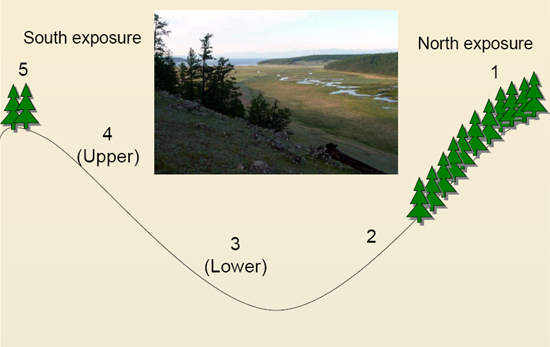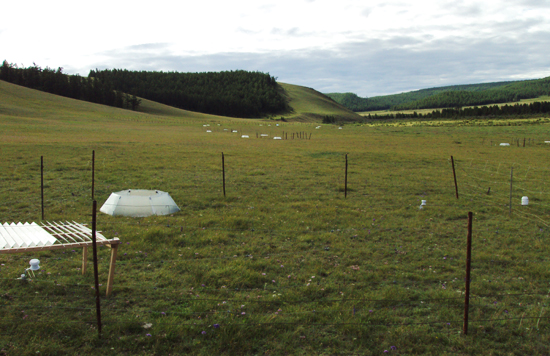Researchers: Dr. Brenda Casper, Dr. Brent Helliker, Dr. Pierre Liancourt, Dr. Alain Plante
During the summer of 2008, we determined that both the non-warming control and the warming chambers (OTC) increased mean daily temperatures by approximately 2°C, with no difference between the two chambers. In 2009, we replaced the non-warming controls with an open-sided design (OSC) projected to more accurately simulate the greenhouse radiation effect.
 |
| Schematic representation of the study site. Numbers refer to locations of the 2009 experiments described below. |
1-2-3-4: Effect of warming (OTCs increase air temperatures by ~ 2°C and soil temperatures by ~ 1°C) on soil respiration.
3-4: Effect and the interaction between warming (OTCs and OSCs mainly warming at night) and grazing (fences) on species composition, functional composition and trait distribution.
3-4: Intensity and direction of biotic interactions on specialist and ubiquitous species along the topographic gradient.
3: Selective removal of the dominant species Carex pediformis to test how it filters the community composition, functional composition and phenology. The experiment will be coupled with a seed supplementation experiment from species mainly occuring at site 4 and having a low abundance or not at site 3.
3-4: Mycorrhizal community: We documented at least 8 mycorrhizal speces among the genera Acaulospora, Glomus and Scatellopora.
3-4: Within species differentiation along the topographic gradient and the differential response of 'ecotypes' to the warming and grazing treatments using reciprocal transplantation and removal experiments.
 |
| Warming and grazing treaments on the lower south exposure (3). |
Other PIRE Mongolia Research Projects
- Tree-ring Study: Tree-ring isotope reconstruction of larch (Larix sibirica) physiological response to increased temperatures and CO2 enrichment
- Carbon Stocks: Assessment of belowground carbon stocks in forest and steppe
- Modelling: Steppes and forests as alternative states and integration of field studies
- Monitoring: Monitoring of climate, permafrost and stream hydrology
- Nomadic Herders: Survey of the impacts of nomadic grazing patterns




